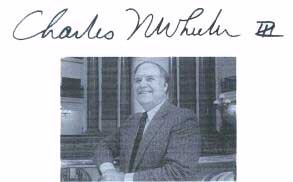 |
Home | Search | Browse | About IPO | Staff | Links |
 |
Home | Search | Browse | About IPO | Staff | Links |
|
POLITICS

It's the 20th anniversary of the regrettable Cutback Amendment by Charles N. Wheeler III
"Don't cut off your nose to spite your face." Is there anyone anywhere who doesn't remember those words of wisdom from a parent during a time of childhood pique? The admonition holds true for grown-ups, too, of course, with the consequences of indulging one's emotions usually more serious than in the typical youthful snit. Indeed, this month marks the 20th anniversary of what is perhaps the most regrettable example of short-sighted anger in state history: voter approval of the 1980 Cutback Amendment. The change cut the size of the Illinois House by one-third, established single-member districts and eliminated Illinois' 110-year-old practice of cumulative voting, a system that virtually assured minority party representation throughout the state. Under cumulative voting, three members were elected from every district. Each voter had three votes, all of which could be given to a single candidate, or divided 1.5 each between two, or split one apiece among three candidates. The amendment was championed by self-styled populist reformer Patrick Quinn, who capitalized on public outrage at 40 percent pay raises lawmakers voted themselves in a lame-duck legislative session two years earlier.
The debate over the amendment tended to focus on its impact on the legislative process. What most appealed to voters, though, may have been the chance to fell 59 politicians at a single blow. Now, two decades later, it's possible to make some judgments about how accurate each camp's predictions were. First, the proponents, who said the Cutback Amendment would: • Save $7 million a year because fewer lawmakers means a smaller payroll and fewer administrative expenses. Indisputably, the cutback did save taxpayers the cost of salaries, benefits and district office allowances for the 59 lawmakers whose jobs were abolished. But operating expenses for the last 177-member House were $9.8 million in its last full budget year, compared to a $25.1 million tab for the 118-member House this fiscal year. The 156 percent increase is less, though, than the 193 percent jump in total general fund outlays. • Streamline the process, making the House more efficient and productive because fewer lawmakers mean fewer bills introduced, a smaller staff, and a smoother operation. The 177 representatives elected to the last "big" House 20 years ago introduced 2,690 bills over two years. With the fall session yet to go, the current House crop has tossed 4,748 bills into the hopper. And while full-time House professional staff numbered 90 in 1980, the ranks swelled to 449 for last spring's session. • Promote competition and enhance accountability because one-on-one contests will encourage more folks to run in smaller districts and make it easier to oust entrenched incumbents. In this election, though, candidates in 57 House districts have no opposition, one fewer than the number of uncontested races in 1998. In the final years of cumulative voting, almost all districts had four candidates seeking three seats. In the three elections preceding the cutback. House incumbents seeking new terms succeeded 95 percent of the time; in the most recent three elections, the success rate dipped to 94 percent. On the other hand, how prescient were the opponents? Besides disputing the proponents' claims, foes warned the amendment would: • Deny representation for members of the minority party in a given area. Since the cutback, only one Chicago-based district has sent a Republican to the House (for nine straight elections), although more than 200,000 city dwellers cast Republican votes in the last gubernatorial election. Similarly, no Democrat has been elected from DuPage County, where two years ago more than 71,000 residents voted Democratic. • Promote regional rivalry. With only one Chicago voice in its midst, city concerns have not been a 42 November 2000 Illinois Issues www.uis.edu/~ilissues priority for the suburban-dominated GOP House caucus. House Democrats are not as parochial, thanks to a handful of suburban lawmakers who give the caucus a broader perspective. Under cumulative voting, of course, every district usually elected at least one member from each of the two major parties. • Concentrate power in leadership hands. Rank-and-file members nowadays like to complain that party leaders make all the important decisions, then expect the back-benchers to ratify them. Flaunting one's independence and flouting the leadership was easier in the old days, when a rebel needed to garner only 26 percent of a four-way vote to win one of three seats. • Reduce the number of women and minorities in the House.
Current House membership includes 33 women (28 percent), 15 blacks (13 percent) and 4 Hispanics (3 percent), making it more diverse than the last 177-member House, whose ranks included 27 women (15 percent), 15 blacks (8 percent) and no Hispanics. On balance, it seems clear that few of the Cutback Amendment's promised benefits ever materialized, while most of the dire consequences opponents foresaw have come to pass. The disappointing 20-year record has renewed interest in the old system on several fronts: • Restoring cumulative voting is being studied by an electoral reform panel led by former Gov. Jim Edgar and retired U.S. Appellate Judge Abner Mikva, both veterans of the "big" House. • The Illinois League of Women Voters is reviewing the impact of the Cutback Amendment, which it supported in 1980. • A grass-roots group, Illinois Citizens for Proportional Representation, is pushing a constitutional amendment to restore cumulative voting through its Web site, http://www.prairienet.org/icpr/. The rash choices of childhood often can't be undone. Happily, that may not be true of the lamentable Cutback Amendment. Charles N. Wheeler III is director of the Public Affairs Reporting program at the University of Illinois at Springfield.
www.uis.edu/~ilissues November 2000 Illinois Issues 43
|
|
|